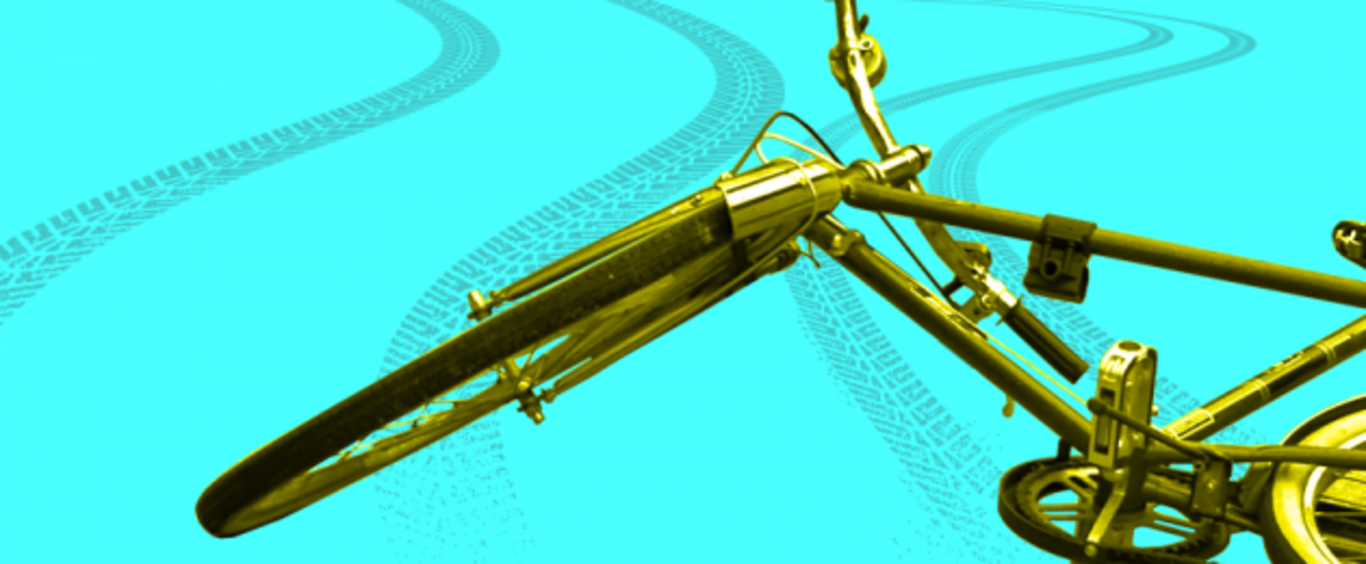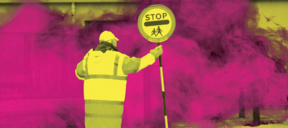'Cyclists are taking their life in their hands': Exposing poor bike infrastructure across Ireland
The second part of Noteworthy’s in-depth investigation analyses complaints to uncover the main problems facing cyclists.

“FOR PEOPLE STUCK behind windscreens, it’s frustrating… but for those of us with wind in our hair, it’s unpleasant. You have to rev yourself up sometimes.”
Martina Callanan from Galway Cycling Campaign cycles into town on the Headford Road, a congested route that goes to the university. Though Galway has the second highest percentage of commuters cycling in a city, Callanan said “you’re mainly sharing the roads with other motor vehicle users and there are very few dedicated cycle tracks”.
According to the campaigner, the bike lane on her route “is essentially a pavement”. This is dangerous for cyclists as “it is cut across by access roads to retail parks so you have to come off the path frequently” where other traffic is given priority.
In part one of this investigation, we analysed Road Safety Authority (RSA) cyclist injury data from 2005 to 2016. Today, we reveal the top cycle-related complaints to city councils, how poor infrastructure is affecting cyclists and how this can lead to injuries which can cost local authorities thousands in public liability claims.
To do this, we analysed injury and bicycle-related complaint data as well as hundreds of pages of documents. We found:
COMPLAINTS:
- Almost 60% of the recent cycling-related complaints we analysed were about bike lanes;
- The top bike lane and road issue was poor surface mainly due to potholes;
- Broken glass was the top reported cleaning request, followed by gravel and leaves.
CLAIMS:
- Public liability claims have been brought against many councils in relation to bike falls, slips or collisions in recent years;
- Between all the Dublin councils, except for South Dublin who did not provide us with a breakdown, 178 claims were made amounting to over €110,000 (of those complete) from 2017 to 2020.
***
Call for cycle lanes
Noteworthy compiled data from complaints we obtained through freedom of information (FOI) requests to the city councils (from 2018 to date) and by scraping over 7,600 road-related reports on FixYourStreet.ie (from 2019 to date). View a map of the final scraped reports we used here. Those that had coordinates were mainly in Dublin.
Not all city councils shared their data with us, but we analysed almost 1,500 complaints from Limerick, Waterford, Dun Laoghaire-Rathdown, Fingal and Galway City councils. From all of this data, we found over 600 complaints directly related to cycling.
A high res version of this graph can be found here.
Over 20% of cycle-related complaints were about the provision of infrastructure with the top of these being about bike parking. Almost a quarter of the reports were people asking councils to install cycle lanes at locations around Ireland, mainly in urban areas.
Many cyclists described the current infrastructure as unsafe with one Galwegian writing to the council: “Cyclists are taking their life in their hands trying to reach cycle lanes on Bothar na dTreabh from Parkmore. I recently have taken out income protection for this purpose only.” (Received by Galway City Council, September 2019)
Callanan from the Galway Cycling Campaign knows the roads there well. Her nearby cycle route, the Headford Road, is a blackspot for bikes as there were 16 cyclist collisions, including two serious injuries, along a 1km length of this route, from 2005 to 2016.
Callanan describes her journey along this route in the video below where you can see the large roundabouts and junctions she navigates.
This 560m of cycle track on this road was given a C2 rating in the latest Galway Transport Strategy, published almost four years ago. It stated that “C-rated facilities are more varied”. They include on-road cycle lanes and “cycle lanes in poor condition or below standard” and “allow for a degree of sharing of the road space, sometimes with relatively high speed traffic and / or large vehicles”.
This strategy proposes to extend the inbound bus lane “which can also be used by cyclists”, add signage “to reduce motorised traffic speeds” and “advertise the presence of cyclists”.
Responding to poor infrastructure
In Galway, they have implemented a Cycle Bus “as a response to the lack of cycle infrastructure”, explained Callanan. This initiative involves a number of volunteers and parents who cycle with a group of children to ensure they get to school safely.
Another initiative set up due to poor cycling infrastructure is iBikeDublin. Alan Downey, who showed us his journey into town from Fairview in part one of this investigation, has taken part in a number of “bike lane protection” measures with this campaign group.
“We get together a bunch of cyclists and will line up along the edge of the bike lane so nobody can stop or park in it. It allows people cycling to use the small amount of safe infrastructure that we are provided with and keep it clear.”
One section of road where they have taken this action is at O’Connell Bridge. The bridge and its junctions had 19 collisions, including one fatality and one serious injury over the 12 years of data we analysed. The fatality occurred on the junction with Aston Quay which was the most dangerous part of the quays with two fatalities, one serious and five minor injuries within 270m.
 One of the ‘bike lane protection’ measures taken on O’Connell Street near the bridge.
One of the ‘bike lane protection’ measures taken on O’Connell Street near the bridge.
Dublin City Council said that the planned cycle scheme on the quays “is unlikely to be in place before 2024” so they are currently designing an interim scheme from Phoenix Park to O’Connell Street. Christopher Manzira, the council’s senior transportation officer, said they “hoped to have it implemented by August” and in spite of the pandemic “are still working broadly to that timeline”. To do this they plan to install ‘wand’ bike lane protectors.
However, it was reported recently in the Business Post that the Dublin City Centre Traders Alliance, whose members include Brown Thomas and its carpark as well as Arnotts and Jervis Shopping Centre, has said it will take the City Council to court if it does not apply for planning permission for this temporary cycle route.
FOI documents the Sunday paper obtained showed Owen Keegan, Dublin City Council’s chief executive, wrote in an email that these objections were “hardly a surprise” and “I presume we will plough on”. The council said it had the authority under the road traffic legislation to set up a temporary cycle route. Dublin Chamber of Commerce which represents 1,300 businesses are supporting the scheme.
Problematic design
These protectors were recently installed by the council on a contra-flow cycle lane on a different section of road, Lombard Street East, near Pearse Street Station. However, an example of a cycle-unfriendly junction, according to the many cyclists who contacted Noteworthy, sits just opposite on the other side of the road.
You can watch cyclist Paddy Monahan on the video below take us on his cycle through this junction and explain why it is problematic.
To prevent designs like this in future, Monahan said there needs to be “better inclusion of cyclists” in the design of roads as well as the prioritisation of cycling, sustainable transport and people with disabilities.
Dublin City Council told Noteworthy that it is redesigning this route. Manzira explained that “the changes will include the upgrade of that junction and the island which is creating some ambiguity between car drivers and cyclists. That will be resolved as soon as we are able to go back into work, probably June [2020].”
Facing obstacles
Another issue which contributes to cyclist injuries is the poor surface of bike lanes and roads. In fact, Noteworthy found that 46% of all cycle-related road complaints were about this, with half of these in relation to potholes.
A high res version of this graph can be found here.
A large number of complaints state that a cyclist fell off their bike and in some cases were injured. This is one of the calls logged by the local authorities: “Waterford Ambulance Service reported that he was nearly killed. Very large pothole at the junction of Viewmount Park and Ballinakill Road and his front wheel of bicycle went into the crater.” (Received by Waterford City and County Council, January 2019)
In addition to potholes on roads, many were also reported on bike tracks. This report is from Fix Your Street: “There’s a deep pothole in the cycle lane (northbound) that caused me to crash off my bike, as it was full of rainwater so I didn’t see it.” (Geotagged: Bray Road near Kilbogget Park in South Dublin, August 2019)
Potholes can cost councils thousands in public liability claims. For example, we found through FOI that Limerick City and Council paid an average of over €150,000 annually on all claims relating to potholes from 2014 to 2018, though this rose to almost €250,000 from January to October last year.
Public liability claims have also been brought against many councils in relation to bike falls, slips or collisions in recent years. Between all the Dublin councils, except for South Dublin who did not provide us with a breakdown, 178 claims were made amounting to over €110,000 (of those complete) from 2017 to 2020. Dublin City had the most of these with 118 claims and over €96,000 in payouts.
Cork City Council also refused to give Noteworthy their public liability claim details or copies of complaints we requested through the FOI process. However, the Fix Your Street reports we obtained about the city noted “sloppy cycle lane markings”, “potholes in the cycle lane” and a traffic light in the cycleway which “is dangerous for unsuspecting cyclists”.
 Road surface at Parnell Square East submitted as part of a recent complaint to Dublin City Council
Road surface at Parnell Square East submitted as part of a recent complaint to Dublin City Council
Another issue that is repeated across Ireland is parked cars and other traffic in bike lanes. Noteworthy found that almost 10% of all cycle-related road complaints were about them being blocked.
Cork Cycling Campaign have been concentrating on this issue for the past two years. Conn Donovan, its chair, said “it’s very worrying because most of the cycle lanes in Cork are in the city centre and used by less experienced cyclists”. If a car parks there, you have to perform a manoeuvre to merge back into the road, he explained. “That’s tricky for someone who’s new to cycling and completely unnecessary.”
Donovan said that weekends are the most frustrating, in particular along Alfred Street near the train station. “There is very little parking from nine to five as they know it’s an area that’s been flagged [to Cork City Council] but then the warden clocks off and the cars flock into the cycle lane.”
When asked about this, Cork City Council said that “traffic wardens are very aware of the issues which can be caused by vehicles parking in cycle lanes and enforce [the] same across the entire city. Obviously traffic wardens cannot be everywhere at once but we have an enforcement regime which targets areas of higher incidence of non-compliance.”
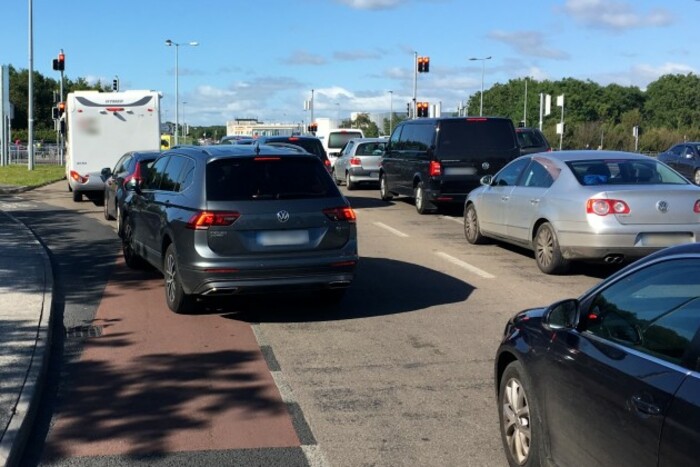 Cars blocking the cycle lane while stopped at traffic lights, Headford Road, Galwa
Cars blocking the cycle lane while stopped at traffic lights, Headford Road, Galwa
To address the issue of parking in cycle lanes in Dublin, the council “has set itself a target of 10 km of protected cycle lane for 2020”, according to Manzira, and they hope to achieve twice that next year. Once these protections are installed, they will also try “to make them 24/7 cycle lanes” as at the moment cars can legally park in them at certain times.
Slippery issues
Maintenance of cycle lanes and roads was a big driver of complaints from the data we obtained. Requests for the council to clean sections of cycle lanes accounted for almost 25% of complaints that related to roads. The top issue was broken glass, followed by gravel and leaves.
Some punctures were reported by cyclists due to glass or hedge-cutting while slips were occurring mainly due to unswept leaves. Lack of gritting of cycle lanes was also an issue with icy surfaces reported.
A high res version of this graph can be found here.
One problem encountered by Dublin City Council with the sweeping of cycle lanes, in particular those protected by wands, is they do not have a road sweeper to clean them as the “big sweepers do not have the capability of sweeping on the locations where we will be putting in these delineators”. They are currently working on identifying “appropriate sweepers which would be sufficiently small to use”.
Oil was also mentioned but in less than 2% of complaints we analysed. However, this became a major issue on Dublin’s roads earlier this year when the Dublin Cycling Campaign noticed an increasing trend on social media of cyclists posting images of slips and falls.
They began to collect reports, mapped them and “saw clusters near construction sites”, explained Kieran Ryan, communications coordinator for the group. In response to this, Dublin City Council inspected the sites and committed to prioritising the cleaning of these junctions. For one oil spill, they found evidence that it was related to an adjacent construction site so they treated the road and served a notice to the contractor.
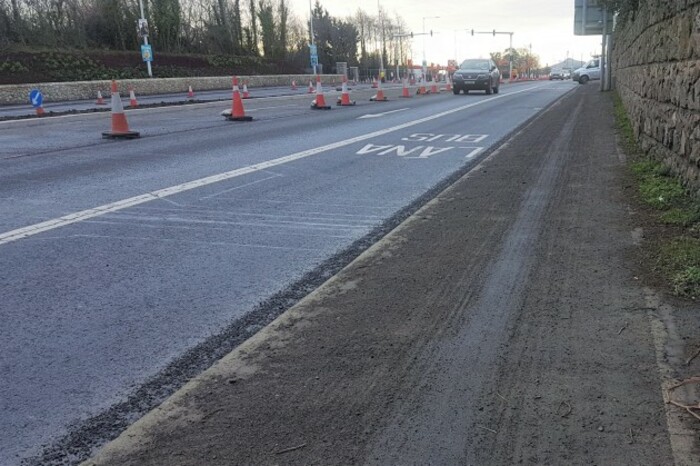 Gravel on a cycle lane in Cabinteely (Dún Laoghaire-Rathdown)
Gravel on a cycle lane in Cabinteely (Dún Laoghaire-Rathdown)
Untracked funding
There are cycling plans and strategies in place in a number of towns and cities across Ireland and if there isn’t any, there should be by the end of this year. Local authorities have a deadline of December to “set forth a clear pathway and timetable for the installation of dedicated cycling infrastructure”.
This is one of the actions of the Climate Action Plan which was published by the Government last year. It also states that “current transport infrastructure programmes [are] to immediately be revised to achieve at least 10% expenditure on facilitating cycling”.
However, when Noteworthy contacted the city councils about their cycling spend, some could not provide a detailed breakdown as budgets were allocated as part of wider transport projects in many instances.
Fingal County Council said “in relation to the request for capital works on cycling infrastructure FCC do not track expenditure on cycling infrastructure as a specific category of spend”. Cork City Council refused this aspect of our FOI request as “the record concerned does not exist or cannot be found”.
Limerick City and County Council said “it is estimated that 20% is spent on cycling infrastructure plans”. A breakdown of the planned cycle network was provided by Galway City and County Council with phase one and two costing an estimated 14.65 and 17.5 million respectively, “subject to NTA approval and funding”.
Waterford City and County Council provided a breakdown to Noteworthy. They stated that the capital spend on cycling infrastructure was €111,000 from 2015 to date. “However, the Waterford Greenway which was officially opened in 2017 was the biggest infrastructural investment… at a total cost of €17 million”.
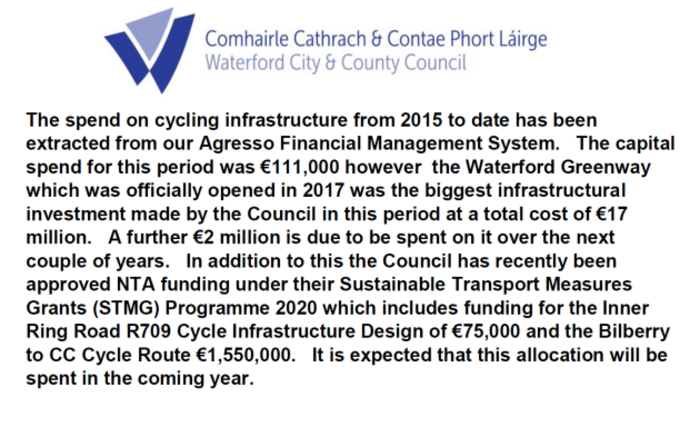 Extract of FOI document provided to Noteworthy
Extract of FOI document provided to Noteworthy
Another issue with cycling funding is that budgets are often pooled together with walking infrastructure. For instance, “Budget 2020 provided for approximately €114 million to support walking and cycling related initiatives and infrastructure”, according to a spokesperson from the Department of Transport. They said that approximately €91 million of this was “split across NTA-led investment programmes supporting active travel”, with the other €23 million allocated to the Greenways Strategy.
“It goes without saying” that the government should be allocating more money to cycling infrastructure, according to the RSA’s communications manager, Brian Farrell. He added that “it really boils down to investment in infrastructure”.
It’s absolutely critical that you look at separating cyclists from the rest of the traffic.
While waiting for better infrastructure, he said that their job is “to identify where risk and dangers are on the roads and to educate people on behaviour”. He said it is critical “to educate drivers of their responsibility as regardless of who is at fault, the main cause of death and injury among cyclists is when a collision occurs”.
A recent RSA report on cyclist injury trends found that for over 90% of cyclist injuries another vehicle was involved in the collision, cars for 84% and goods vehicles for most of the remainder.
A cyclist can pay for a mistake with their lives, explained Farrell, but “if a driver makes a mistake, the worst they’ll have to do is maybe go to a garage”.
***
While cyclists wait, Dublin Cycling Campaign’s Ryan is positive about the future. “Every new cycle route that has been complete, encourages more people to cycle. The more people that cycle, the greater the chances of creating more cycling infrastructure.”
For Callanan, Galway is a perfect city for bikes due to its size and she hopes more people will take up cycling. “When I go to town, it’s less than two kilometres from where I live. Cycling is a fast, cheap, independent way of going from A to B and a great way of getting exercise in the day without having to plan it”. However, she is still often shaken by experiences on her cycle home.
“We need segregated protected cycle paths, to be separate from other motor vehicles and to feel safe.”
***

This is part two of an in-depth investigation carried out by Noteworthy, the investigative journalism platform from TheJournal.ie. It was proposed and funded by you, our readers, as well as with support from the Noteworthy general fund.
With the volume of data we obtained, we took the decision to expand the investigation in order to conduct sufficient analysis and create multimedia visualisations. If you would like to help towards the cost of this additional work, please support the general fund here.
You can also support our work by helping to fund one of our other investigation proposals or submitting an idea for a story. Click here to find out more >>


